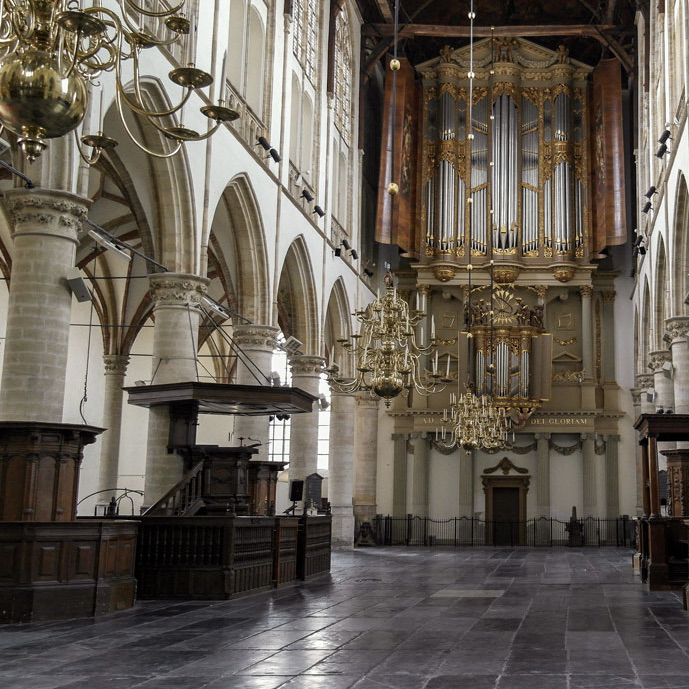VAN HAGERBEER / SCHNITGER
Grote Sint Laurenskerk Alkmaar
Organ details
History
- 1652-53 large changes by Jacobus van Hagerbeer
- 1685 and 1704 small changes by Roelof Barentsz. and his son Johannes Duytschot
- 1722-1725 rebuilding in North-German style by Frans Caspar Schnitger
- 1781-1782 restoration by Johannes Strumphler
- 1823 restoration by A. van Gruisen
- 1843-44 restoration by Dirk Sjoerds Ypma
- 1854 restoration by C.F.A. Naber
- 1897-98 restoration by J. Fr. Witte
- 1947-49 restoration by D.A. Flentrop
- 1982-1986 restoration by Flentrop Orgelbouw
- 2015 restoration by Flentrop Orgelbouw
In the year 1638 the organ-builder Levijn Eekman from Amsterdam was ordered to join both small choir organs of St. Laurens Church into one larger instrument. After Eekmans early death the task was taken over by the famous Dutch organ-builders Galtus, Germer and Jacobus van Hagerbeer. In 1639 it was decided to construct a new much larger organ equipped with 3 manuals and 31 stops. The famous painter/architect Jacob van Campen (1595–1665) designed the organ case in classical style. The painter Caesar van Everdingen (ca. 1617–1678) from Alkmaar was ordered to make the paintings at the large hinged doors, depicting a Biblical scene: ‘The triumph of King Saul after David has defeated Goliath’ (after I Samuel 18:6-7). The instrument, which was regarded as the showpiece of the art of organ-building in Holland in the 17th century, was completed in 1646.
In 1685 and 1704 the organ was repaired and changed by the renowned organ-builders Duytschot from Amsterdam. In 1722 Gerhardus Havingha from Groningen was appointed town-organist. Within a short time he convinced the municipality of Alkmaar about the necessity of a large renovation. The task was given to the North-German organ-builder Frans Caspar Schnitger (1692–1729), from whose work Havingha was a fervent advocate. Between 1723 and 1725 Schnitger completed a big 3-manual organ with 56 stops in North-German style behind the (unchanged) organ-front of Jacob van Campen. Despite the fact that the examination report was full of praise about the work of Schnitger, this renovation was criticized very strongly in Holland and resulted in a fierce controversy between Havingha and his Dutch opponents, who defended the Dutch tradition of organ-building. The published reactions on Havinghas book “Oorspronk en Voortgang der ORGELEN, met de voortreffelijkheid van Alkmaars Groote ORGEL…” [“Origin and Progress of the ORGANS, with the excellence of the large ORGAN of Alkmaar…”] from 1727 by Jacob Wognum and Eneas Veldcamps testify of this. However, Schnitgers renovation of the Alkmaar organ should have an important influence on the development of Dutch organ-building in the 18th century. After this the organ underwent no major changes.
In 1781–82 the organ was repaired and changed by Johannes Strumphler from Amsterdam. At the same time the outward appearance was changed by means of a repainting of the organ case. In the 19th century the organ was repaired and changed by the organ-builders Van Gruisen (1823–24), Ypma (1843–44), Naber (1854) and Witte (1897–98). After a very threatening period (1898–1946) the organ was restored carefully by D.A. Flentrop between 1947 and 1949. After this restoration the instrument obtained a worldwide reputation as an outstanding baroque organ, which resulted in numerous recordings. In the 1960s the condition of the instrument worsened in such a way that another restoration became inevitable. After a long period of preparation, fund-raising and thorough research a large-scale restoration was started in 1982 by Flentrop Orgelbouw, Zaandam. Starting-point was a complete restoration of the Schnitger situation. After extensive research the organ case regained its 17th-century colours. The hinged doors were restored too. The festive inauguration took place in June 1987. Since then the organ enjoys a worldwide reputation as an exceptionally well-preserved baroque organ and testifies in its superb sound qualities to the mastery of its makers!
© Frank van Wijk (2001)
Multimedia library
Specification
| I. Rugpositief C-d3 | II. Groot Manuaal C-d3 | III. Bovenwerk C-d3 | Pedaal C-d1 | |
| Praestant I-II 8 Quintadena 8 Octaav 4 Fluit 4 Nasaat 3 Quintfluit 3 Superoctav 2 Waldfluit 2 Quintanus 1 1/2 Sexquialtera II Mixtuur V-VI Cimbel III Trompet 8 Fagot 8 Vox Humana 8 Tremulant | Praestant 16 Praestant 8 Praestantquint 6 Octaav 4 Quinta 3 Octaav 2 Flachfluit 2 Ruyschpyp II Tertiaan II Mixtuur VI Trompet 16 Viool di Gamba 8 Trompet 4 | Praestant 8 Baarpyp 8 Rohrfluit 8 Quintadena 8 Octaav 4 Fluit Dous 4 Spitsfluit 3 Superoctaav 2 Speelfluit 2 Sexquialtera II Scherp IV Cimbel III Trompet 8 Hautbois 8 Vox Humana 8 Tremulant | Principaal 22 Praestant 16 Rohrquint 12 Octaav 8 Quinta 6 Octaav 4 Nachthoorn 2 Ruyschpyp III Mixtuur VIII Basuin 16 Trompet 8 Trompet 4 Cornet 2 | Couplers: Rp-GM RP-BW GM-BW P-RP P-GM Four cut-out valves Pitch: a1 = 415 Hz Temperament: equal temperament Wind pressure: 84 mm Wind supply: six wedge bellows |




